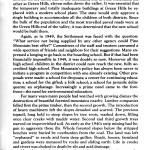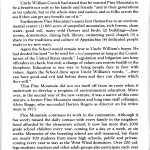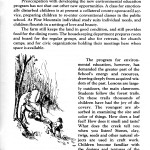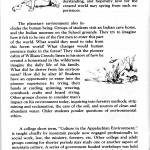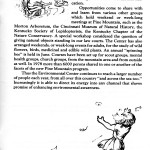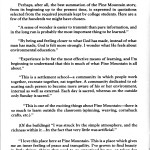Pine Mountain Settlement School
Series 04: Pine Mountain Settlement School Histories
THE PINE MOUNTAIN STORY – CH. V
TAGS: The Pine Mountain Story – Ch. V ; Environmental Education: 1972- ; end of PMSS elementary school ; devastation of land due to lumbering and strip mining ; Uncle William’s hopes ; Alvin Boggs ; visiting groups ; community activities at PMSS ; journal entries about PMSS by college students ;
THE PINE MOUNTAIN STORY – CH. V contains the images and transcription of Chapter V of “The Pine Mountain Story 1913-1980.” This chapter describes “Environmental Education: 1972- .”
The booklet was written and illustrated in 1980 by Mary Rogers. Mary was a PMSS worker for over 50 years and wife of Burton Rogers, director of the School from 1949 to 1973.
For other chapters and more about “The Pine Mountain Story 1913-1980” and the author, Mary Rogers, go to GUIDE TO “THE PINE MOUNTAIN STORY 1913-1980.”
CONTENTS: The Pine Mountain Story – Ch. V
Environmental Education: 1972- ; Mary Rogers illustrations ; end of PMSS elementary school ; devastation of land due to lumbering and strip mining ; reasons for PMSS environmental education center ; Uncle William’s hopes ; Alvin Boggs ; community contact ; visiting student groups ; gift shop ; workshops ; fold dance parties ; community activities at PMSS ; class for emotionally disturbed children ; environmental education activities ; Indian cave home and museum ; Creech cabin ; college and adult groups ; government funded workshops for educators ; January terms with college credit ; interns ; week-long events for adults ; journal entries about PMSS by college students ;
GALLERY: The Pine Mountain Story – Ch. V
- Mary Rogers: The Pine Mountain Story – Ch. V. [pmss-story025.jpg]
- Mary Rogers: The Pine Mountain Story – Ch. V. [pmss-story026.jpg]
- Mary Rogers: The Pine Mountain Story – Ch. V. [pmss-story027.jpg]
- Mary Rogers: The Pine Mountain Story – Ch. V. [pmss-story028.jpg]
- Mary Rogers: The Pine Mountain Story – Ch. V. [pmss-story029.jpg]
- Mary Rogers: The Pine Mountain Story – Ch. V. [pmss-story030.jpg]
- Mary Rogers: The Pine Mountain Story – Ch. V. [pmss-story031.jpg]
- Mary Rogers: The Pine Mountain Story – Ch. V. [Illustration.jpg]
TRANSCRIPTION: The Pine Mountain Story – Ch. V
[pmss_story025.jpg]
CHAPTER V
ENVIRONMENTAL EDUCATION: 1972–
By the end of the sixties it became obvious that the county would soon have to terminate the elementary school at Pine Mountain. For more than eleven years there had been two Harlan County grade school districts on the north side of the mountain, one at Pine Mountain, the other at Green Hills, eleven miles down the valley. It was essential that the temporary and totally inadequate buildings at Green Hills be replaced with a modern school plant. The state would only approve a single building to accommodate all the children of both districts. Since the bulk of the population and the most travelled paved roads were at the Green Hills end of the valley, it was determined that the new school would be built there.
Again, as in 1949, the Settlement was faced with the question: “What service not being supplied by any other agency could Pine Mountain best offer?” Committees of the staff and trustees canvassed a wide spectrum of friends and neighbors for their suggestions. Many expressed a longing to go back to the boarding school. But if that had been financially impossible in 1949, it was doubly so now. Moreover all the high school children in the district could now reach the new, fully accredited high school. Pine Mountain’s policy has always been never to initiate a program in competition with one already existing. Other proposals were made: a school for dropouts; a center for continuing education; a school for the gifted; a folk school; a school for juvenile delinquents; an orphanage. Increasingly a prime need came to the forefront—the need for environmental education.
For many years many people had watched with growing dismay the destruction of beautiful forested mountains nearby. Lumber companies felled first the prime timber, then the second growth. The introduction of heavy machinery left the slopes denuded and scarred. The precious topsoil, long held to steep slopes by tree roots, washed down, filling once clear creeks with muddy water. Second and third growth trees starved on impoverished soil. As early as the 1940s strip mining had begun to aggravate these ills. Whole forested slopes below the stripped benches were buried by overburden from the coal. The land was left “orphaned” to erode and form deep gullies. Roads, houses, farmland and gardens were menaced by rocks and sliding earth. Life in creeks and rivers was choked to death by silt and acid drainage.
Many big-scale drives, during the 1960s, attempted to improve the economy. Highways were blasted out of the mountains to attract industry, in the expectation that mountain people would become “like other Americans”—affluent, consuming, and capitalizing on assets and resources. A growing tree was a wasted commodity, coal unmined a sign of lack of enterprise.
25
[pmss_story026.jpg]
Over-population, over-consumption, waste of resources, all were nationwide. Disregard for the fragile cycles of nature was impoverishing the quality of life throughout the land—polluting, poisoning, disrupting. Future generations were being robbed of their heritage in order to pander to the greed of the present one. Every country of the world was in need of a change of values, and a deeper understanding of the processes by which life on earth is maintained.
Uncle William Creech had stated that he wanted Pine Mountain to be a benefit not only to his family and friends “and to their generations as yet unborn, but to the whole state and nation, and to folks across the sea if they can get any benefit out of it.”
Furthermore Pine Mountain’s assets lent themselves to an environmental center: (1) 800 acres of unspoiled mountains, rich forests, clean water, good soil, many wild flowers and birds; (2) buildings—classrooms, dormitories, dining hall, library, swimming pool, chapel; (3) a share in the traditions and culture of Appalachia; (4) dedicated people ready to try new ways.
Again the School would remain true to Uncle William’s hopes. He had deeded his land “to be used for school purposes as long as the Constitution of the United States stands.” Legislation and litigation can keep offenders in check, but only a change of values can restore health to the biosphere. Education is one way to bring people face to face with values. Again the School drew upon Uncle William’s words, “…they can have good and evil laid before them and they can choose which they will.”
Thus Pine Mountain did not cut itself off from its roots when it undertook to develop a program of environmental education. Moreover, in the second year of the new venture, it was a native of this community, a former Pine Mountain student and long time staff colleague, Alvin Boggs, who succeeded Burton Rogers as director on his retirement in 1973.
Pine Mountain continues its work in the community. Although it has sorely missed the daily contact with every family in the neighborhood afforded by the elementary school, it now has more than 2000 grade school children every year, coming for a day or a week, or six weeks. Memories of the boarding school are still treasured, but there are nearly 500 students from many high schools, public and private, coming every year to stay at the West Wind dormitory. Over 200 college students, teachers and other adult groups also participate each year in the new educational venture. Neighbors sell their crafts in the gift shop, and also teach in workshops at the School. “Folk dance parties” are still popular, and local young people share their traditional dances with visiting groups.
In the summer the grounds are filled with ball players and picnickers who still consider Pine Mountain “our School.” Crowds come from…
26
[pmss_story027.jpg]
…the community for swimming, for family reunions, for the annual Fair Day, and for weddings and funerals at the chapel. The Nativity Play is now a community production. People from all phases of the School’s history, young and old, present the play more beautifully than ever before, bringing to the experience renewed reverence and deepened understanding.
Preoccupation with developing the new environmental education program has not shut out other new opportunities. A class for emotionally disturbed children is at present a collateral county-sponsored service, preparing children to re-enter conventional classes in the public school. At Pine Mountain individual study suits individual needs, and children flourish in a setting of love and beauty.
The farm still keeps the land in good condition, and still provides food for the dining room. The housekeeping department prepares room and board for the regular groups, and also for retreats, for church camps, and for civic organizations holding their meetings here when space is available.
[Illustration: Ink sketch by Mary Rogers of leader with children on a forest trail.]
The program for environmental education, however, has demanded the greater part of the School’s energy and resources, drawing deeply from acquired wisdom of the past. Lessons are largely outdoors, the main classroom. Students follow the forest trails. On these trails thousands of children have had the joy of discovery. The youngest are absorbed in examining the size and color of things. How does a leaf feel? How does it smell and taste? What does the creek tell you when you listen? Stones, clay, twigs, seeds and other natural objects are used in craft work. Children become familiar with the designs and textures of the world of nature. Older students explore what is needed to keep a plant or animal alive, winter and summer, in caves, water, soil. They wonder how these rocks and caves were formed, how soil is made. They examine the role of water in shaping the earth. They ask questions and seek the answers. What is a tree? What kinds of trees are there? wild flowers, mosses and ferns? What processes take place on the forest floor…
27
[pmss_story028.jpg]
[Illustration: Ink sketch by Mary Rogers of boy sitting on grass reaching toward a rabbit.]
…as nature recycles materials needed to maintain all living things? They come to understand how the physical life of the world is wholly dependent on the gift of energy received from the sun. Observation, a sense of wonder, a measure of understanding, and hopefully love for the created world may spring from such experiences.
[Illustration: Ink sketch by Mary Rogers of bird, rabbit, turtle in nature.]
The planetary environment also includes the human being. Groups of students visit an Indian cave home, and the Indian museum on the School grounds. They try to imagine how it felt to be one of the first men to enter this part of the world. What would they need to take from this forest world? What changes would human presence make in the forest? They visit the pioneer cabin of William Creech; listen to his story of how he created a homestead in the wilderness; imagine the daily life of his family. What did he derive from his environment? How did he alter it? Students have an opportunity to enter into the pioneer experience by trying their hands at carding, spinning, weaving, cornshuck crafts and board riving. Other groups choose to consider man’s impact on his environment today, inquiring into forestry methods, strip mining and reclamation, the care of the soil, and sources of clean and abundant water. Older students ponder questions of environmental ethics.
A college short term, “Culture in the Appalachian Environment,” is taught chiefly by mountain people now engaged professionally in social work, law, the ministry, forestry, etc. Other college and adult groups coming for shorter periods may study one or another aspect of mountain culture. A series of government funded workshops was held in 1973 for school administrators, teachers of science and mathematics, social studies, language arts, fine and industrial arts, school librarians and teachers of the elementary grades. The purpose of the series was to help educators think through ways in which they could inculcate sound environmental attitudes in teaching their different subjects.
28
[pmss_story029.jpg]
[Illustration: Ink sketch by Mary Rogers of two children reaching across water towards a turtle.]
Regular January terms, carrying college credit, concentrate on the theme “Background for Environmental Education.” Many of these students return to Pine Mountain as interns, to delve more deeply into both the theory and the practice of environmental education.
Opportunities come to share with and learn from various other groups which hold weekend or week-long meetings at Pine Mountain, such as the Morton Arboretum, the Cincinnati Museum of Natural History, the Kentucky Society of Lepidopterists, the Kentucky Chapter of the Nature Conservancy. A special workshop considered the question of giving natural objects standing in our law courts. The Center has also arranged weekends, or week-long events for adults, for the study of wild flowers, birds, medicinal and edible wild plants. An annual “spinning bee” is held in June. Courses have been set up for scout groups, mental health groups, church groups, from the mountain area and from outside as well. In 1978 more than 6000 persons shared in one or another of the facets of the new Pine Mountain program.
Thus the Environmental Center continues to reach a larger number of people each year, from all over this country “and across the sea too.” Increasingly it is able to direct its energy into any channel that shows promise of enhancing environmental awareness.
[Illustration: Ink sketch by Mary Rogers of little girl in dress, reaching for falling leaves.]
[pmss_story030.jpg]
“What is this place anyhow?”
“Why is it here?”
“What went on here in the past?”
“What happens here now?”
Perhaps, after all, the best summation of the Pine Mountain story, from its beginning up to the present time, is expressed in quotations selected from the required journals kept by college students. Here are a few of the hundreds we might have chosen.
“A sense of wonder is easier to transmit than pure information, and in the long run is probably the most important thing to be learned.”
“By being and feeling closer to what God has made, instead of what man has made, God is felt more strongly. I wonder what He feels about environmental education.”
“Experience is by far the most effective means of learning, and I’m beginning to understand that this is much of what Pine Mountain is all about.”
“This is a settlement school—a community in which people work together, recreate together, eat together. A community dedicated to educating each person to become more aware of his or her environment, internal as well as external. Each day is sacred, whereas on the outside only Sunday is sacred.”
“This is one of the exciting things about Pine Mountain—there is so much to learn outside the classroom (spinning, weaving, cornshuck crafts, etc.).”
(Of the buildings) “I was struck by the simple atmosphere, and the richness within it…by the fact that very little was artificial.”
“I love this place here at Pine Mountain. This is a place which gives me an inner feeling of peace and tranquility. I’ve grown to find beauty in little things, things that used to go unnoticed by me, or taken for granted.”
“Time to meditate during the organ music in chapel last night was one of the most precious and uplifting times I’ve had in quite a while.”
30
[pmss_story031.jpg]
“I thought today how people here, and such a place as this, create such a special atmosphere, and make people want to learn and come back again and again.”
“This journal represents more thinking than I’ve done in the last four months combined. Pine Mountain strikes a chord in me. Every facet of living we cover here seems to be a facet I wish to incorporate in my life. This has been a month of wonderment.”
“I may travel many roads in my life and do many things. I may grow old and tired and my mind may become worn out and forgetful, but I am thoroughly convinced that as long as I live, there is no force in the universe could cause me to forget my living and growing and the close friends I have made at Pine Mountain. With grateful thanks…”
[Illustration.jpg]
[Illustration: Full-page ink sketch by Mary Rogers of Chapel alter and window.]
SEE ALSO:
GUIDE TO “THE PINE MOUNTAIN STORY 1913-1980”
THE PINE MOUNTAIN STORY – CH. I
Chapter I – The Pine Mountain Area Before 1913
THE PINE MOUNTAIN STORY – CH. II
Chapter II – The Early Years of Pine Mountain Settlement School: 1913-1930
THE PINE MOUNTAIN STORY – CH. III
Chapter III – The Boarding High School: 1930-1949
THE PINE MOUNTAIN STORY – CH. IV
Chapter IV – Community School in Cooperation with the County: 1949-1972
MARY ROGERS Biography

